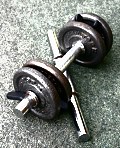 I’ve played guitar – classical, acoustic, electric – for over three decades, ever since I pilfered my sister’s nylon string at the age of 12, although even before that, I’d had a couple of those mini toy guitars with actual strings at various points in my childhood. Even though I never took a single guitar lesson, I eventually learned to follow music and guitar tablature, but was only really any good at keeping up with a score if I’d already heard someone else play the music, it don’t mean a thing if it ain’t got that swing…after all.
I’ve played guitar – classical, acoustic, electric – for over three decades, ever since I pilfered my sister’s nylon string at the age of 12, although even before that, I’d had a couple of those mini toy guitars with actual strings at various points in my childhood. Even though I never took a single guitar lesson, I eventually learned to follow music and guitar tablature, but was only really any good at keeping up with a score if I’d already heard someone else play the music, it don’t mean a thing if it ain’t got that swing…after all.
Meanwhile, I took up singing in a choral group (called bigMouth) and have felt compelled to become ever so slightly more adept at reading music in a slightly more disciplined environment than jamming on guitars with friends. Big Mouth formed in the autumn of 2007 and we meet weekly for singing practice and have now done a few small “local” gigs. We even put together a last-minute audition video tape for the BBC’s Last Choir Standing, but didn’t make it through to the heats, (un)fortunately.
Anyway, that’s probably enough detail. The point I wanted to make is that until I joined Big Mouth and began making music regularly with a group, I’d always felt like I was quite useless at remembering people’s names. Like many people I’d always had to make a real conscious effort to keep new names in mind. However, in the last few months, with no deliberate action on my part, I’ve noticed that I seem to remember stuff like fleeting introductions, the names of people mentioned in conversations, or press releases and other such transient data much better than before.
I’m curious as to whether it’s the ever-so-slightly more formal discipline of group music practice that’s done something to the wiring in my brain or whether it’s simply to do with expanding one’s social group in a sudden burst like this. Ive heard of people claiming increased brain power after taking music lessons, here you can find piano teaching resources. It’s probably a combination of both and my suspicions about the power of music for boosting the brain are bolstered somewhat by a recent TED talk from Tod Machover and Dan Ellsey on the power of music
I also wonder whether there’s some connection with the Earworms concept for language learning, which I reviewed back in 2006.
 Earlier this week, I went to see “one” of my childhood musical heroes, progressively rocking Canadian three piece Rush. The band was on top form as ever and the crowd jostled to the music almost in synchrony like so many atoms in a Bose-Einstein condensate (BEC) as the band raised the energy levels. They played most of their latest album, covering themes of humanism and faith without religion as well as resurrecting some stonkers from their vast back catalogue including the epic Natural Science from 1980 album Permanent Waves.
Earlier this week, I went to see “one” of my childhood musical heroes, progressively rocking Canadian three piece Rush. The band was on top form as ever and the crowd jostled to the music almost in synchrony like so many atoms in a Bose-Einstein condensate (BEC) as the band raised the energy levels. They played most of their latest album, covering themes of humanism and faith without religion as well as resurrecting some stonkers from their vast back catalogue including the epic Natural Science from 1980 album Permanent Waves. Over on Alex King’s blog, they’re offering suggestions for his workout playlist. Dozens of comments have rolled in with music ranging from Eye of the Tiger to Linkin Park to Pussycat Dolls and everything in between.
Over on Alex King’s blog, they’re offering suggestions for his workout playlist. Dozens of comments have rolled in with music ranging from Eye of the Tiger to Linkin Park to Pussycat Dolls and everything in between. Fed up with using up so many batteries? Rechargeables giving you poor mileage? Then why not try a couple of sweet potatoes instead.
Fed up with using up so many batteries? Rechargeables giving you poor mileage? Then why not try a couple of sweet potatoes instead. Infrared and NMR spectroscopy have possibly revealed one of the great secrets of the violin makers Stradivari and Guarneri del Gesu – they used chemical wood preservatives to help preserve their instruments and to improve the tonal quality. The discovery could help modern-day violin makers emulate more closely the properties of irreplaceable violins from the 18th Century and well as providing music conservationists with new insights on how to best preserve the antique instruments.
Infrared and NMR spectroscopy have possibly revealed one of the great secrets of the violin makers Stradivari and Guarneri del Gesu – they used chemical wood preservatives to help preserve their instruments and to improve the tonal quality. The discovery could help modern-day violin makers emulate more closely the properties of irreplaceable violins from the 18th Century and well as providing music conservationists with new insights on how to best preserve the antique instruments. BB King had his Lucille, old slowhand his well-worn Strat, and who could forget Jimmy Page with his Gibson SG twin-neck? You too could join the greats and learn how to play guitar, thanks to new technology from Australia’s science research centre – CSIRO. And, all you have to do is put on their new designer shirt and start strumming…the air.
BB King had his Lucille, old slowhand his well-worn Strat, and who could forget Jimmy Page with his Gibson SG twin-neck? You too could join the greats and learn how to play guitar, thanks to new technology from Australia’s science research centre – CSIRO. And, all you have to do is put on their new designer shirt and start strumming…the air.
